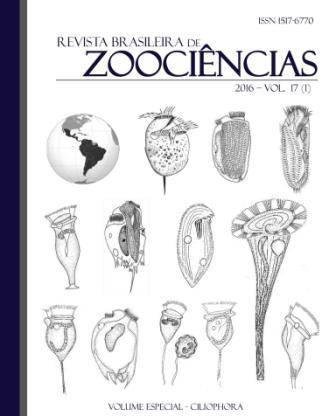Optimized culture and growth curves of two ciliated protozoan strains of Paramecium caudatum Ehrenberg, 1833 to use in ecotoxicologycal assays
Resumo
Protozoans are microbial eukaryotes known to be ideal for aquatic ecotoxicological testing. Therefore, aiming to evaluate their possible use in standardized ecotoxicity assays we determined the best cultivation conditions and growth curves for two strains of the ciliated protozoan Paramecium caudatum Ehenberg 1833. One strain (PC1) was isolated from the Monjolinho reservoir-SP (22° 01’ S and 47° 53’ W) where the mean dissolved O2 is 5.205 mgL-1, pH 6.43 and electrical conductivity 34.75 μS cm-1. The other strain (PC2) from the Óleo lagoon in Jataí Ecological Station- SP (21° 36’ S and 47° 49’ W), with mean dissolved of 4,42 mgL-1, pH 4.90 and electrical conductivity 10.96 μS cm-1. The higher mean cellular biovolume and density obtained were used to evaluate different cultivation parameters such as temperature, pH, light exposition, stirring regimen and cultivation flask size. Considering protozoan densities and cell biovolume, the best culture conditions for PC1 strain was pH 9.0 at 30 °C and for PC2 was pH 7.0 at 27.5 °C. For both strains and evaluated parameters (biovolume and density), the bottle size did not interfered in the results and absence of light resulted in better ones. Concerning agitation, for PC2, there was no significant difference for this parameter and for PC1 in the absence of shaking we obtained better results. Therefore we decided to make the tests in the absence of light and without shaking. Regarding cell biovolume, the best condition was pH 9.0 at 25 ° C for the PC1 strain and pH 8.0 at 20 ° C for PC2 strain. The generation time calculated in a 96 hours growth curve was 8.35 hours for PC1 and 7.6 hours for PC2. In the end of the experiment, the number of generations (n) and maximum population (N) were higher for PC2 than for PC1 and were, 11.02 and 10.78, respectively, for n values and 7548 and 6400 for N ones. The growth strategies of the two strains were quite different but both were considered suitable for laboratorial growth and use for ecotoxicity tests in standardized conditions.Downloads
Não há dados estatísticos.
Downloads
Publicado
2016-11-04
Edição
Seção
Artigos



